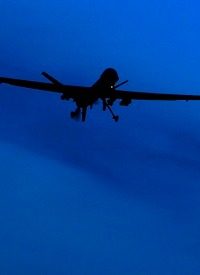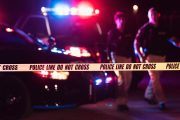
Ranches spread for thousands of acres on the wide open ranges of North Dakota. The sheriff knew that better than anyone else, and he knew that the rifle-toting resisters could be waiting for him anywhere, so he came prepared. The cavalry called in to assist Sheriff Janke consisted of highway patrolmen, a SWAT team, an explosives detonation squad, and deputies from surrounding counties.
There was one other member of the posse: a Predator drone.
The Predator B flew two miles above the ground, surveying the area using the state of-the-art optics and sensors with which it is equipped for finding the enemy in the battlefield.
In this case, the unmanned surveillance vehicle spotted the three men from the night before and reported to its human counterparts that the suspects were unarmed. Upon receiving the encouraging data from the Predator, the sheriff and his men swooped in and made three arrests.
This was a historic event. For the first reported time, a U.S. Air Force Predator drone was used in the tracking and arresting of U.S. citizens within the territory of the United States. News out of North Dakota, however, indicates that local law enforcement has employed the military drones on several occasions. As the Los Angeles Times reports:
Local police say they have used two unarmed Predators based at Grand Forks Air Force Base to fly at least two dozen surveillance flights since June. The FBI and Drug Enforcement Administration have used Predators for other domestic investigations, officials said.
“We don’t use them [drones] on every call out,” said Bill Macki, leader of the Grand Forks SWAT team that participated in the arrests of the suspect cattle rustlers.
The drone called out by Sheriff Janke is operated by the U.S. Customs and Border Protection. While they are typically deployed to monitor traffic across the northern and southern borders of the United States — illegal aliens and drug smugglers, mostly — the use of the drones by local and state law enforcement has gone without much discussion.
Should there be much discussion? Aren’t citizens made safer through the use by police of every available resource in the prevention of crime and the apprehension of dangerous individuals? In a word: no.
In the case described in this article, a weapon built for and owned by the armed forces of the United States is being used for the purposes of domestic law enforcement in direct violation of the Posse Comitatus Act of 1878.
The Posse Comitatus Act limits local police agencies from using the federal military to enforce the law. The Army and Air Force (specifically mentioned in the statute) may be used only to maintain “law and order” if such an act is passed by Congress. No such act of Congress has been passed; thus no such use is authorized.
There is a chance, however, that if the National Defense Authorization Act of 2012 is passed and signed into law by the President, the Posse Comitatus Act will be legislatively repealed, as the former law would explicitly empower the President to use the armed forces to arrest and detain U.S. citizens of the United States living within the United States who are suspected of being “enemy combatants.”
The plain language of the statute would indicate that the sheriff and all those within the military and Customs Agency who authorized the deployment of the Predator drone are subject to prosecution and to fines or imprisonment. The relevant part of the law reads:
Whoever, except in cases and under circumstances expressly authorized by the Constitution or Act of Congress, willfully uses any part of the Army or the Air Force as a posse comitatus or otherwise to execute the laws shall be fined under this title or imprisoned not more than two years, or both.
As of 2006, the Posse Comitatus Act was amended to permit the President to “employ the armed forces … to … restore public order and enforce the laws of the United States … as a result of a natural disaster, epidemic, or other serious public health emergency, terrorist attack or incident, or other condition.”
Setting aside the constitutionality of the change in the law effected by the 2006 law, the question of the prosecution of the North Dakota sheriff still lingers.
Even some who otherwise advocate the expanded use of Predator drone technology in domestic crime fighting argue that the “routine” employment of such without “clear legal authority” is a long step down a very slippery slope.
One opponent of such unlawful cooperation between local police and the federal military is raising the warning voice once again. Said former Rep. Jane Harman (D-Calif.), “There is no question that this could become something that the people will regret.”
During her time in Congress, Harman worked to block efforts by the Department of Homeland Security to use military satellite imagery in the investigation of suspected terrorist activity within the United States.
Even a cursory reading of the Posse Comitatus Act would reveal the illegality of such a use of military resources.
Another opponent of the use of drones for the surveillance of citizens of the United States is Ryan Calo, director for privacy and robotics at the Stanford Law School Center for Internet and Society. Calo was quoted by the Los Angeles Times article saying,
Any time you have a tool like that in the hands of law enforcement that makes it easier to do surveillance, they will do more of it. This could be a time when people are uncomfortable, and they want to place limits on that technology. It could make us question the doctrine that you do not have privacy in public.
If Sheriff Janke is indicted for his unconstitutional use of military resources in the execution of local law, then, if the story printed in the Sacramento Bee is reliable, he has several co-conspirators who should also be indicted for the same crime.
The Bee relates how Janke learned of his ability to call in the Predator to fight crime:
In North Dakota, Janke learned about the Predators last spring after local law enforcement was invited to a briefing on how two Customs and Border Protection drones based at the Grand Forks Air Base could assist police. He immediately saw its advantages.
In the case of the missing cows, the drone was able to inform the sheriff of the precise location and real-time imagery of the suspects. Who monitored the video imagery being sent live from the Predator’s cameras? The Bee answers that question: “Janke watched the live Predator feed from his office computer, using a password-protected government website called Big Pipe.”
While all constitutionalists support the lawful efforts of local police to protect and serve citizens, they certainly oppose all such open and hostile violations of the Posse Comitatus Act and of the civil liberties guaranteed by the Constitution. They know that they should not be willing to trade liberty for safety — for if they do, in the end they will be left with neither.
Photo of Predator B drone: AP Images



